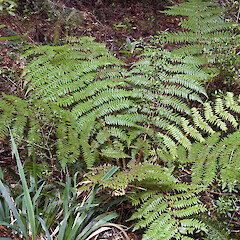Alsophila colensoi
Common name
rough tree fern, mountain tree fern
Synonyms
Cyathea colensoi (Hook.f.) Domin
Family
Cyatheaceae
Flora category
Vascular – Native
Endemic taxon
Yes
Endemic genus
No
Endemic family
No
Structural class
Ferns
NVS code
The National Vegetation Survey (NVS) Databank is a physical archive and electronic databank containing records of over 94,000 vegetation survey plots - including data from over 19,000 permanent plots. NVS maintains a standard set of species code abbreviations that correspond to standard scientific plant names from the Ngä Tipu o Aotearoa - New Zealand Plants database.
CYACOL
Chromosome number
2n = 138
Current conservation status
The conservation status of all known New Zealand vascular plant taxa at the rank of species and below were reassessed in 2017 using the New Zealand Threat Classification System (NZTCS) – more information about this can be found on the NZTCS website. This report includes a statistical summary and brief notes on changes since 2012 and replaces all previous NZTCS lists for vascular plants.
Please note, threat classifications are often suggested by authors when publications fall between NZTCS assessment periods – an interim threat classification status has not been assessed by the NZTCS panel.
- Conservation status of New Zealand indigenous vascular plants, 2017 . 2018. Peter J. de Lange, Jeremy R. Rolfe, John W. Barkla, Shannel P. Courtney, Paul D. Champion, Leon R. Perrie, Sarah M. Beadel, Kerry A. Ford, Ilse Breitwieser, Ines Schönberger, Rowan Hindmarsh-Walls, Peter B. Heenan and Kate Ladley. Department of Conservation. Source: NZTCS and licensed by DOC for reuse under the Creative Commons Attribution 4.0 International licence.
2017 | Not Threatened
Previous conservation statuses
2012 | Not Threatened
2009 | Not Threatened
2004 | Not Threatened
Brief description
Small tree fern with green-stalked roughish leaves to 1.5 m long. Trunk to 1 m tall or not present. Leaf stems covered in small red and white star-shaped hairs, star-tipped scales and pointed scales (lens needed). Sporangia arranged in small round hairy clusters underneath fronds.
Distribution
Endemic. North Island ( from Mt Pirongia and the Kaimai Range south), South Island, Stewart Island/Rakiura.
Habitat
Montane to subalpine in dense forest, along stream courses, often near the bush line, sometimes extending into subalpine scrub.
Detailed description
Trunks prostrate, or erect (up to 1 m tall). Stipes slender, pale brown, finely rugose, bearing numerous scales. Scales pale brown to red-brown, lacking margin spines. Fronds up to 1.5 m long, held upright, 3-pinnate, soft; dead fronds falling (not persistent). Longest primary pinnae 150–400 mm long, adaxially hairy, abaxially covered in red stellate hairs and scales ending in single or stellate spines. Indusia absent; long hairs present amongst sporangia. (Description adapted from Brownsey & Smith-Dodsworth (2000)).
Similar taxa
Most often confused with young Alsophila smithii with which it sometimes grows but distinguished by its prostrate to shortly erect trunk, finely and copiously hairy upper frond surface, absence of an indusia, and by the long hairs protruding from the sorus.
Flowering
Not applicable—spore producing
Flower colours
No flowers
Fruiting
Not applicable—spore producing
Propagation technique
Difficult to grow and probably best left well alone. Some success has been had planting specimens into a rich, permanently damp soil within a shaded situation. Dislikes humidity and heat.
Etymology
colensoi: Named after William Colenso (7 November 1811 - 10 February 1899) who was a Cornish Christian missionary to New Zealand, and also a printer, botanist, explorer and politician.
Where To Buy
Occasionally available from specialist native plant nurseries.
Attribution
Fact sheet prepared for NZPCN by P.J. de Lange 22 March 2011. Description adapted from Brownsey & Smith-Dodsworth (2000).
References and further reading
Brownsey PJ, Smith-Dodsworth JC. 2000. New Zealand Ferns and Allied Plants. David Bateman, Auckland, NZ. 168 p.
NZPCN Fact Sheet citation
Please cite as: de Lange, P.J. (Year at time of access): Alsophila colensoi Fact Sheet (content continuously updated). New Zealand Plant Conservation Network. https://www.nzpcn.org.nz/flora/species/alsophila-colensoi/ (Date website was queried)








